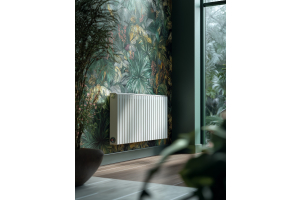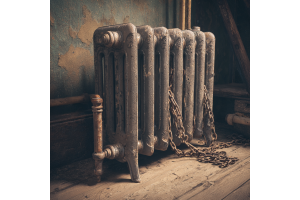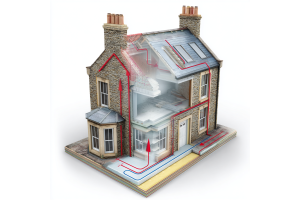
As summer fades and cooler evenings creep in, autumn is the perfect time to get your home ready for the months ahead. A few simple adjustments now can make your space warmer, more energy-efficient, and more inviting — while also saving you money when the heating season kicks in.
At Geyser, we believe that comfort and efficiency go hand-in-hand. Here are seven easy but effective changes you can make this autumn to keep your home cosy and energy-smart.
1. Check & Bleed Your Radiators
As autumn approaches, one of the simplest yet most important maintenance tasks is checking your radiators. Over the warmer months, air can build up inside your heating system, creating air pockets that prevent hot water from circulating properly. The result? Radiators that feel cold at the top but warm at the bottom — and a heating system that works harder (and costs more) to do less.
Why Bleeding Matters
-
Restores full heating power: Trapped air reduces your radiator’s ability to heat a room evenly.
-
Improves efficiency: Your boiler won’t need to work as hard to compensate for underperforming radiators.
-
Lowers energy bills: Efficient heat output means you use less energy to stay warm.
-
Prevents long-term damage: Leaving air trapped inside radiators can encourage corrosion and sludge buildup.
How to Bleed a Radiator: Step-by-Step
-
Turn on your heating system and let it warm up fully. Walk through your home and note any radiators with cold spots.
-
Switch off the heating and let the system cool slightly — this avoids hot water spraying out.
-
Locate the bleed valve (usually at the top side of the radiator). You’ll need a radiator key (widely available at DIY stores).
-
Place a cloth or small container under the valve to catch drips.
-
Insert the key and turn slowly anti-clockwise. You’ll hear a hissing sound as trapped air escapes.
-
Once water flows steadily, tighten the valve back up — don’t overtighten.
-
Check your boiler pressure gauge. Bleeding may lower system pressure, so top it up if needed.
Tip: Start with radiators downstairs and work upwards, finishing with the highest one in your home.
When to Go Beyond Bleeding
If your radiators still feel patchy after bleeding, or if they take a very long time to heat, the issue might be sludge buildup (rust and debris inside the system). In this case, a professional power flush can restore performance.
For older radiators that struggle even after maintenance, upgrading to modern, efficient models is the smarter move. Geyser’s aluminium radiators heat up quickly, retain warmth efficiently, and complement modern heating controls — giving you a much better return on energy use.
Key Takeaway: Bleeding radiators is quick, free, and hugely effective. By spending just 10 minutes per radiator, you can improve efficiency, cut heating costs, and prepare your home for a warmer, smoother autumn.
2. Inspect Your Boiler & Heating System
Your boiler is the heart of your home’s heating system, and just like a car engine, it performs best when it’s serviced regularly. Autumn is the ideal time for a full inspection — before cold snaps place extra demand on your system. A quick check now could save you from unexpected breakdowns, costly repairs, and even safety risks later in winter.
Why a Boiler Service Matters
-
Safety First: Faulty boilers can leak carbon monoxide — an odourless, invisible gas that poses serious health risks. An annual service ensures all safety checks are completed.
-
Efficiency Boost: A clean, well-maintained boiler uses less fuel, lowering energy bills and reducing strain on your system.
-
Reliability: Preventative servicing reduces the chance of a breakdown when you need heat the most.
-
Longevity: Regular care helps extend your boiler’s lifespan, saving money in the long term.
What to Check Yourself
Even before calling a professional, there are simple tasks you can carry out:
-
Check the boiler pressure: Most systems should sit between 1.0 and 1.5 bar. If it’s too low, top it up using the filling loop.
-
Listen for unusual noises: Banging, gurgling, or whistling can point to trapped air, limescale, or pump issues.
-
Inspect for leaks: Look for damp patches or dripping pipes near the boiler and radiators.
-
Test the thermostat: Make sure it responds accurately and switches the boiler on when needed.
Professional Servicing
It’s strongly recommended to book a Gas Safe registered engineer for an annual service. A professional will:
-
Clean internal boiler components.
-
Check for carbon monoxide leaks.
-
Inspect the heat exchanger, burner, and seals.
-
Test flue gases for safe operation.
-
Verify boiler efficiency.
For peace of mind, ask your engineer for a service certificate, which may also be required if your boiler is under warranty.
Beyond the Boiler: Heating System Care
Your heating system is more than just the boiler:
-
Radiators: Once bled, check for uneven heating — this may signal sludge buildup, requiring a system flush.
-
Pipes & Valves: Insulate exposed pipes, especially in lofts or unheated areas, to prevent freezing and heat loss.
-
Hot Water Cylinder: If you have one, add or check insulation to keep water hotter for longer.
-
Smart Controls: Autumn is a good time to review heating schedules and update smart thermostats for seasonal changes.
When to Consider an Upgrade
If your boiler is 10–15 years old, inefficient (rated C or below), or breaking down regularly, replacing it with a modern, energy-efficient model could save hundreds annually. Pairing a new boiler with Geyser’s efficient aluminium or designer radiators ensures that heat is delivered quickly and evenly across your home, maximising your investment.
Key Takeaway: A quick autumn inspection of your boiler and heating system ensures safety, reliability, and efficiency. Combine a serviced boiler with well-maintained radiators, and your home will be ready for the cold season without nasty surprises.
3. Seal Draughts Around Windows & Doors
Even the most powerful heating system can’t compete with cold air sneaking in through gaps and cracks. Draughts not only make rooms feel uncomfortable but also waste heat and money — forcing your radiators and boiler to work harder than they should. The good news? Draught-proofing is one of the simplest and most affordable home improvements, often paying for itself within a single winter.
Why Draught-Proofing Matters
-
Energy Savings: The Energy Saving Trust estimates that blocking draughts can save the average UK household £60–£100 a year.
-
Comfort Boost: A draught-free home feels warmer at a lower thermostat setting, reducing the temptation to turn the heat up.
-
Radiator Efficiency: Without cold air rushing in, your Geyser radiators can warm rooms evenly, instead of battling against constant heat loss.
-
Health Benefits: Eliminating cold spots helps prevent condensation, damp, and mould growth.
Common Draught Hotspots
-
Windows: Gaps around frames, poorly fitted sashes, or cracked seals.
-
External Doors: Spaces under or around the frame, letterboxes, and keyholes.
-
Floorboards & Skirting: Small cracks can allow noticeable cold air infiltration.
-
Chimneys & Fireplaces: Unused chimneys often act like funnels for draughts.
-
Lofts & Attics: Around hatches and access panels.
How to Seal Draughts: Practical Solutions
-
Windows
-
Use self-adhesive foam strips for quick fixes.
-
Install rubber or brush seals for longer-lasting results.
-
Apply secondary glazing film (a clear plastic sheet) over single-pane windows in winter for extra insulation.
-
-
Doors
-
Fit draught excluder brushes or rubber strips around the frame.
-
Add a door sweep or draught excluder sausage at the bottom.
-
Use spring-loaded letterbox covers to prevent heat loss through mail slots.
-
Install a simple keyhole cover to block small but noticeable gaps.
-
-
Floors & Skirting
-
Seal gaps with flexible filler or decorator’s caulk.
-
Use rugs over bare floorboards for insulation and comfort.
-
-
Chimneys
-
If unused, fit a chimney balloon or chimney draught excluder (removable when needed).
-
-
Loft Hatch
-
Add foam strips around the edges and ensure insulation covers the hatch lid.
-
DIY or Professional?
Most draught-proofing fixes are DIY-friendly and inexpensive. However, for larger jobs like replacing old window frames or fitting double/triple glazing, professional installation ensures the best long-term results.
When to Rethink Your Windows & Doors
If your windows or doors are very old, warped, or single-glazed, sealing alone may not be enough. Investing in modern, energy-efficient models (especially double-glazed windows) will significantly reduce heat loss and improve your home’s value. Until then, draught-proofing provides a cost-effective short-term solution.
Key Takeaway: Sealing draughts around windows and doors is a low-cost, high-impact upgrade. Not only does it reduce wasted heat and lower bills, but it also allows your Geyser radiators to work at peak efficiency, giving you a warmer, cosier home this autumn.
4. Upgrade Your Home Insulation
Turning up the heat won’t make much difference if your home can’t hold onto it. Insulation is one of the most powerful ways to reduce energy waste — yet many UK homes are still under-insulated. Without it, as much as a third of household heat is lost through walls, roofs, and floors, meaning you’re literally paying to heat the outdoors.
Autumn is the perfect time to upgrade insulation before the coldest months hit, locking warmth in and making every radiator in your home far more effective.
Why Insulation Is Essential
-
Energy Savings: Proper insulation can cut heating costs by up to 40% depending on your property’s age and structure.
-
Comfort: Well-insulated homes stay warm longer, with fewer draughts and cold spots.
-
Efficiency: Your Geyser radiators won’t need to run at maximum output to keep rooms cosy.
-
Sustainability: Reducing energy demand lowers your carbon footprint, supporting the UK’s net-zero goals.
-
Future-Proofing: A well-insulated home is better prepared for low-carbon heating systems like heat pumps.
Where to Focus First
-
Loft Insulation
-
Up to 25% of heat escapes through an uninsulated roof.
-
Adding or topping up to the recommended 270mm of mineral wool insulation is one of the most cost-effective upgrades.
-
-
Wall Insulation
-
Cavity walls (common in post-1920s homes): filling the gap can cut heat loss by up to a third.
-
Solid walls (pre-1920s homes): internal or external insulation is pricier but can save around £200–£400 a year.
-
-
Underfloor Insulation
-
Especially valuable for older homes with suspended timber floors.
-
Prevents draughts and stops warmth seeping into the ground.
-
-
Pipe & Tank Insulation
-
Lagging hot water pipes and insulating cylinders reduces wasted energy and keeps hot water warmer for longer.
-
-
Radiator Reflector Panels
-
A low-cost upgrade that reflects heat back into the room instead of letting it escape through external walls.
-
Particularly effective when used behind Geyser’s slimline or designer radiators.
-
Costs vs. Savings
-
Loft insulation: ~£300–£500 installation (DIY cheaper) → save £250+ per year.
-
Cavity wall insulation: ~£1,000–£1,500 → save £200–£300 per year.
-
Solid wall insulation: £7,000+ → save £400+ per year.
-
Draught-proofing and pipe lagging: often under £100 → save up to £100 per year.
These measures usually pay for themselves within just a few years.
DIY vs Professional
-
DIY: Loft insulation top-ups, radiator reflector panels, and pipe lagging are simple jobs most homeowners can do.
-
Professional: Wall insulation, underfloor insulation, and large-scale upgrades require qualified installers for safety and effectiveness.
How It Helps Geyser Radiators Perform
Insulation doesn’t just save money — it maximises the output of your radiators. With less heat escaping, rooms warm up quicker, stay comfortable longer, and radiators can run at lower settings. That means lower energy bills, reduced strain on your system, and a cosier home all autumn and winter.
Key Takeaway: Upgrading insulation is one of the smartest investments you can make. It transforms your home into a warm, efficient, and cost-effective space — and ensures your Geyser radiators deliver peak performance without wasting precious heat.
5. Clean Gutters & Check Roof Integrity
When preparing for autumn, most people think of radiators and insulation — but your home’s first line of defence against the weather is the roof and drainage system. Blocked gutters, cracked tiles, or loose flashing can quickly turn a cosy home into a damp and draughty one.
With autumn leaves, heavy rainfall, and stronger winds on the way, now is the ideal time to inspect, clean, and repair before small issues turn into costly problems.
Why Gutters & Roof Checks Matter
-
Prevents Damp & Mould: Blocked gutters overflow, sending water down external walls. This can lead to damp patches indoors, which not only damage décor but also make rooms feel colder and harder to heat.
-
Protects Insulation: A leaking roof can saturate loft insulation, dramatically reducing its effectiveness. Wet insulation = wasted energy.
-
Stops Heat Loss: Gaps or damage in the roof allow warm air to escape and cold air to enter.
-
Avoids Structural Damage: Water seeping into brickwork, timber, or foundations from faulty drainage can cause long-term costly repairs.
-
Energy Efficiency: A dry, well-sealed roof ensures your heating system and radiators work efficiently, without fighting against cold, damp air.
How to Clean Gutters Properly
-
Safety First
-
Use a sturdy ladder on flat, stable ground.
-
Have someone nearby for support.
-
Wear gloves and protective eyewear.
-
-
Clear Debris
-
Remove leaves, moss, and twigs by hand or with a gutter scoop.
-
Flush gutters with a garden hose to check for proper water flow.
-
-
Check Downpipes
-
Ensure downpipes aren’t clogged.
-
Use a plumbing snake or pressure hose to clear stubborn blockages.
-
-
Inspect for Damage
-
Look for sagging sections, cracks, or joints pulling apart.
-
Reseal leaks with gutter sealant if DIY-friendly, or call a professional if significant.
-
Roof Integrity Checklist
-
Broken or Missing Tiles/Slates: Replace quickly to prevent leaks.
-
Flashing Around Chimneys & Skylights: Ensure it’s sealed and not lifting.
-
Signs of Moss Growth: Moss traps moisture and can damage tiles.
-
Sagging Roofline: Could indicate water damage or structural weakness.
-
Inside Loft Check: Look for damp patches, mould, or daylight coming through.
DIY vs Professional
-
DIY Friendly: Clearing gutters, light moss removal, and visual inspections.
-
Professional Needed:
-
Tile or slate replacement.
-
Structural sagging issues.
-
Large moss removal requiring specialist cleaning.
-
Persistent leaks or insulation damage.
-
Costs vs Savings
-
DIY Gutter Cleaning: Costs little more than your time and some gloves.
-
Professional Gutter Clean: Around £50–£150, depending on house size.
-
Roof Repair: Replacing a few tiles may cost £100–£300, whereas ignoring damage could lead to thousands in repair bills from water ingress and insulation replacement.
How It Connects to Heating Efficiency
A well-maintained roof and drainage system:
-
Keeps loft insulation dry and effective, ensuring heat isn’t lost upwards.
-
Prevents draughts and damp, which make rooms feel colder and force your radiators to work harder.
-
Preserves your home’s structural efficiency, meaning long-term heating savings.
Key Takeaway: A simple autumn weekend spent clearing gutters and checking your roof can save you from costly repairs, protect your insulation, and keep your Geyser heating system running at maximum efficiency all season.
6. Switch to Smart Heating Controls
Autumn is the season where your heating system starts working harder — but that doesn’t mean your bills need to rise sharply. One of the smartest upgrades homeowners can make is installing smart heating controls, which allow you to heat your home with precision, not guesswork.
Instead of relying on a single thermostat or outdated timer, smart systems let you control when, where, and how much you heat, all from your smartphone, tablet, or even via voice assistants like Alexa or Google Home.
Why Smart Controls Matter
-
Energy Efficiency: No more heating empty rooms or running the boiler longer than necessary.
-
Cost Savings: Homeowners save on average 10–20% on heating bills by optimising schedules and reducing waste.
-
Comfort: Rooms can be kept at just the right temperature without overheating.
-
Flexibility: Adjust heating remotely — perfect if you’re coming home earlier or later than expected.
-
Zoned Heating: Control radiators individually, ensuring you only heat spaces that are in use.
Key Features to Look For
-
Smart Thermostats
-
Learn your daily routine and automatically adjust settings.
-
Provide data on your heating habits and usage.
-
-
Zoned Radiator Valves
-
Smart TRVs (thermostatic radiator valves) give room-by-room control.
-
For example: keep the living room cosy in the evening while the bedrooms stay cooler until bedtime.
-
-
Geofencing
-
Uses your phone’s location to turn heating off when you leave home, and back on as you return.
-
-
Weather Compensation
-
Adjusts heating output depending on outside temperatures, improving efficiency.
-
-
Integration with Renewable Energy
-
Works seamlessly with low-carbon systems like heat pumps or solar PV for future-ready comfort.
-
How It Helps Geyser Radiators
Pairing smart controls with designer radiators from Geyser means:
-
Maximum efficiency — radiators heat only when needed.
-
Enhanced comfort — stylish radiators in living areas can be set for evening warmth, while unused rooms stay cooler.
-
Optimised performance — radiators don’t waste energy by working against poor scheduling.
Costs vs. Savings
-
Smart thermostat: ~£150–£300 installed.
-
Smart TRVs: £40–£70 per valve.
-
Potential annual savings: £200–£300 depending on home size and heating habits.
-
Payback period: Typically 2–4 years, faster in larger homes with high energy use.
DIY vs Professional Setup
-
DIY-friendly: Many smart thermostats are designed for easy installation, especially if replacing an existing wired thermostat.
-
Professional install: Recommended if integrating with complex boiler systems, zoning, or renewable heating.
Why Autumn Is the Best Time to Switch
-
You can fine-tune schedules before the coldest winter months.
-
Many suppliers offer discounts in autumn, before peak heating season.
-
Helps you track and control rising energy use as evenings get darker and colder.
Key Takeaway: Smart heating controls are not just a gadget — they’re a practical, cost-saving upgrade that delivers better comfort, lower bills, and improved efficiency. Paired with Geyser’s high-performance radiators, they make your heating system truly work smarter, not harder.
7. Add Seasonal Comfort Touches
Preparing your home for autumn isn’t just about boilers, insulation, or smart tech — it’s also about creating an atmosphere that feels warm, inviting, and energy-efficient. By making simple seasonal changes in décor and soft furnishings, you can keep heat inside longer, reduce reliance on your heating system, and transform your living spaces into cosy retreats during shorter, colder days.
Why Seasonal Comfort Touches Matter
-
Practical Energy Savings: Fabrics like rugs and curtains add insulation to cold floors and draughty windows.
-
Comfort & Wellbeing: A cosy environment helps you feel warmer at lower temperatures, meaning you won’t be tempted to overuse your heating.
-
Low-Cost Upgrade: Unlike major insulation or system upgrades, soft furnishings are affordable, instantly effective, and can be reused year after year.
-
Style & Mood: Autumn styling adds a sense of comfort, calm, and seasonal charm to your home.
Easy Autumn Upgrades
-
Thicker Curtains & Blinds
-
Swap lightweight summer curtains for thermal-lined or heavier fabrics.
-
At night, closing them traps heat inside; during the day, open them to let in free solar warmth.
-
-
Cosy Rugs on Bare Floors
-
Hardwood, tile, and laminate floors lose a lot of heat. Adding thick rugs or runners acts as insulation.
-
Ideal for living rooms, hallways, and especially bedrooms where cold floors are most noticeable.
-
-
Throws & Cushions
-
Layering sofas and beds with warm throws and cushions makes spaces more inviting.
-
Keeps you physically warmer, reducing the urge to crank up the thermostat.
-
-
Seasonal Bedding
-
Swap lightweight duvets for higher tog-rated options (10.5–13.5 tog).
-
Flannel or brushed cotton sheets hold warmth better than standard cotton.
-
-
Draft Excluders & Decorative Touches
-
A stylish draught excluder at the bottom of doors adds both character and insulation.
-
Autumnal décor (candles, lanterns, textured fabrics) adds a sense of warmth that’s psychological as well as physical.
-
Psychological Warmth: The Comfort Factor
Studies show that warm colours and soft textures can influence how warm we feel, even if the actual temperature is unchanged. Introducing shades like burnt orange, deep reds, and earthy browns in accessories can make a room feel snugger without extra energy use.
Cost vs. Savings
-
Thermal curtains: £60–£120 per pair → can save up to £50 a year on heat loss through windows.
-
Rugs & soft furnishings: £100–£200 for a few quality pieces → improve comfort and reduce heating reliance.
-
Duvets & bedding: £40–£100 → keeps bedrooms warmer, often reducing the need for overnight heating.
How It Complements Geyser Radiators
-
By reducing heat loss through floors, doors, and windows, your radiators can run at lower settings while still maintaining comfort.
-
Cosy rooms feel warmer at lower temperatures, meaning your radiators work smarter, not harder.
-
Designer radiators in living spaces become both functional heat sources and stylish focal points, perfectly paired with seasonal décor.
Key Takeaway: Seasonal comfort touches aren’t just about style — they’re an energy-smart strategy. With just a few rugs, curtains, and cosy textures, you can cut heat loss, boost comfort, and let your Geyser radiators perform at their best while creating an autumn-ready sanctuary.
Quick Takeaway: Autumn-Ready in 7 Steps
Preparing your home for autumn doesn’t have to be overwhelming — in fact, it’s all about small, smart changes that add up to big comfort and savings. Here’s your quick seasonal checklist:
-
Check & Bleed Your Radiators
-
Release trapped air so your heating runs smoothly and efficiently.
-
Benefit: Faster heating, lower bills, no cold spots.
-
-
Inspect Your Boiler & Heating System
-
Book a service or do a health check before peak season.
-
Benefit: Fewer breakdowns and better long-term performance.
-
-
Seal Draughts Around Windows & Doors
-
Use draught-proofing strips, sealant, and excluders.
-
Benefit: Stop warm air escaping and instantly cut wasted energy.
-
-
Upgrade Your Home Insulation
-
Focus on lofts, walls, floors, and even behind radiators.
-
Benefit: Lock in heat and make every Geyser radiator more effective.
-
-
Clean Gutters & Check Roof Integrity
-
Clear leaves, fix leaks, and protect loft insulation from damp.
-
Benefit: Prevent damage and keep your home warm and dry.
-
-
Switch to Smart Heating Controls
-
Install a smart thermostat or radiator valves for zoning.
-
Benefit: Heat only the rooms you need, when you need them.
-
-
Add Seasonal Comfort Touches
-
Layer in rugs, curtains, throws, and warm-toned accessories.
-
Benefit: Boost comfort and warmth without extra energy use.
-
Why This Matters
Together, these steps create a layered defence against the cold:
-
Efficiency upgrades (bleeding radiators, insulation, smart controls) cut wasted energy.
-
Preventative checks (boiler service, gutter cleaning) reduce costly breakdowns.
-
Comfort touches (soft furnishings, seasonal accessories) make your home feel warmer without higher bills.
Your Autumn-Ready Advantage with Geyser
With stylish, efficient radiators and a focus on modern heating solutions, Geyser helps you make the most of these autumn upgrades. Whether you’re sealing in heat, switching to smart controls, or just making your home feel cosier, the right radiator is at the heart of it all.
Final Takeaway: Follow these 7 simple steps and you’ll step into autumn with a home that’s warmer, more efficient, and ready for whatever the season brings — all while saving money and enjoying the comfort you deserve.
Conclusion
Autumn is a season of transition — and it’s also the perfect time to prepare your home for colder months. By taking a proactive, layered approach, you can create a home that’s not only warmer and more comfortable but also energy-efficient and cost-effective.
The 7 steps outlined — from checking and bleeding your radiators, inspecting your boiler, sealing draughts, upgrading insulation, cleaning gutters, switching to smart heating controls, to adding seasonal comfort touches — form a comprehensive plan that covers both technical efficiency and cosy comfort. Each step complements the others: while insulation and draught-proofing lock in heat, smart controls and radiator maintenance ensure that heat is distributed efficiently and only where it’s needed.
Key Benefits of Preparing Your Home for Autumn
-
Enhanced Comfort: Warm rooms, fewer draughts, and cosy living spaces.
-
Lower Energy Bills: Efficient radiators, insulation, and smart scheduling save money.
-
Peace of Mind: Serviced boilers, clean gutters, and roof checks prevent costly emergencies.
-
Future-Ready Home: A well-maintained and insulated property is better prepared for low-carbon or renewable heating solutions.
-
Stylish Warmth: Seasonal décor and Geyser designer radiators combine functionality with aesthetics.
Why Geyser Customers Benefit Most
A well-prepared home maximises the efficiency of your heating system. Geyser radiators, whether aluminium, steel, or designer models, perform best in homes that are draught-free, insulated, and correctly controlled. By combining these 7 autumn-ready steps with Geyser products:
-
Heat reaches every room faster.
-
Energy usage is optimised.
-
Overall comfort and warmth are significantly enhanced.
Action Plan
-
Start small: bleed radiators, seal draughts, and add cosy accessories.
-
Gradually tackle bigger projects: insulation upgrades, boiler servicing, and smart heating controls.
-
Monitor your energy usage and comfort levels to fine-tune your heating strategy.
Final Thought: Autumn doesn’t have to mean high heating bills or chilly rooms. With a few smart, simple, and seasonal changes, you can create a warm, efficient, and inviting home — making every Geyser radiator work at its very best while enjoying the comfort and peace of mind that comes with a well-prepared home.







